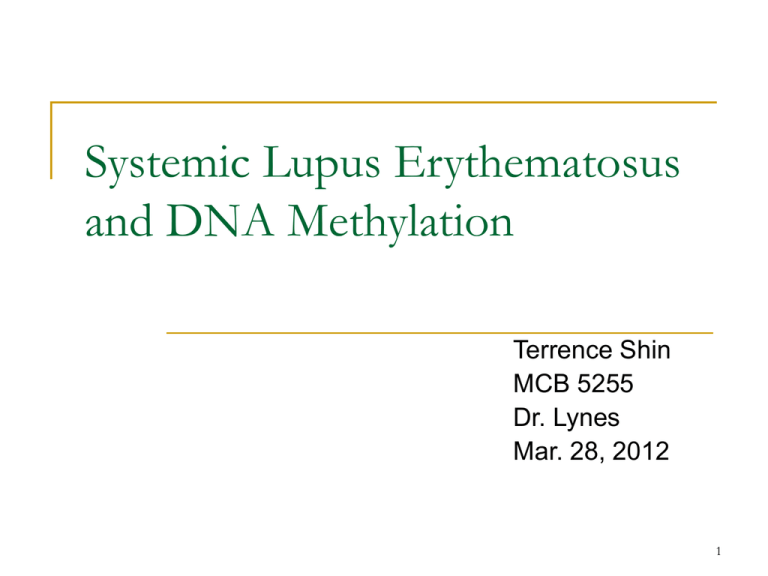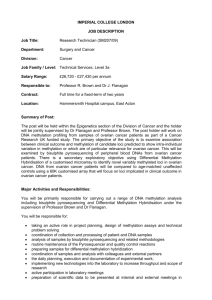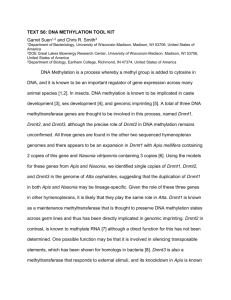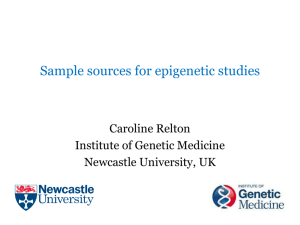HRES-1
advertisement

Systemic Lupus Erythematosus and DNA Methylation Terrence Shin MCB 5255 Dr. Lynes Mar. 28, 2012 1 Systemic Lupus Erythematosus (SLE) Chronic autoimmune disorder Affects skin, joints, kidneys, and others Joint pain and swelling Lupus nephritis Cause – Unknown Ages: 10~50 More common in women African Americans and Asians are affected more often 2 Common Symptoms of SLE Chest pain Fatigue Fever Hair loss Mouth sores Swollen lymph nodes Skin/Butterfly rash Photosensitive 3 Possible Body Parts Targeted by SLE Skin Raynaud’s phenomenon Brain & nervous system Lungs Heart Arrhythmias Tachycardia Bradycardia Digestive tract 4 Diagnosis of SLE CBC ANA Chest x-ray Urinalysis Renal biopsy 5 Patients with SLE met at least four of revised criteria of the American College of Rheumatology. 6 Treatment for SLE No cure Control symptoms Anti-inflammatory medication Corticosteroids Protection from sunlight 7 Ultraviolet B exposure of peripheral blood mononuclear cells of patients with systemic lupus erythematosus inhibits DNA methylation GS Wang, M Zhang, XP Li, H Zhang, W Chen, M Kan and YM Wang Lupus 2009 8 Background Sunlight can induce exacerbation of SLE SLE cells are hypomethylated Ultraviolet B (UVB): 290~320 nm Promoters of transcriptionally active gene DNA methylation Suppressive effects on gene expression 5th position of the cytosine ring Catalyzed by DNMT1 9 Specific Aims What are the effect of UVB on DNA methylation in SLE? What is its significance in the pathogenesis of SLE ? 10 Materials & Methods Study participants Isolation of PBMCs Irradiation protocol DNA extraction and HPCE RNA isolation and RT-PCR Statistical analysis 11 Study Participants 45 patients with SLE 40 females, 5 males Mean age: 36 years; range: 18~61 years Active = SLEDAI ≥ 10 (21 out of 45 patients) 20 healthy volunteers (control) Sex- and age-matched 18 females, 2 males Mean age: 31 years, range: 22~46 years 12 Isolation of PBMCs Total volume of 20 ml of ethylenediaminetetraacetic acid (EDTA)-K2preserved venous peripheral blood drawn from patients & controls Ficoll gradient centrifugation PBMCs PBMCs cultured in RPMI 1640 medium Supplemented with 10% heat-inactivated FBS, 2 mM sodium pyruvate, 100 IU/ml penicillin and 100 μg/ml streptomycin 13 Irradiation Protocol UVB irradiation Waldman UV109B lights with TL-12 lamps (Waldman Lighting Ltd., Germany) Emit within the UVB range (290–320 nm) with an emission peak at 311 nm PBMC were irradiated in PBS with different doses of UVB (0, 50 and 100 mJ/cm2) PBS removed RPMI 1640 containing 10% FBS added cultured (24 h) DNA & RNA extractions 14 DNA Extraction and HPCE Five deoxynucleoside standards purchased from International Laboratory (CA, USA) dA = 2’-deoxyadenosine dT = 2’-deoxythymidine dG = 2’-deoxyguanosine dC = 2’-deoxycytidine mdC = 5-methyl-2’-deoxycytidine All nucleosides were dissolved in ddH2O water 15 DNA Extraction and HPCE (cont.) DNA extraction gDNA extraction kit (QIAmp, DNA mini kit; Qiagen, Hilden, Germany) RNA digestion Added 20 μg/μl RNase A (Sigma-Aldrich, St. Louis, MO) DNA hydrolysis Heated 18 μl of DNA samples for 2 min in boiling water bath cooled rapidly in ice Added 4.5 μl of 10 mM ZnSO4 and 7.5 μl of nuclease P1 (SigmaAldrich, St. Louis, MO) Incubated at 37°C for 16 h Added 7.5 μl of Tris (0.5 M, pH 8.3), and 4.5 μl of alkaline phosphatase (Sigma-Aldrich, St. Louis, MO) and 50 U/ml in 2.5 M (NH4)2SO4 Incubated at 37°C for 2 h 16 DNA Extraction and HPCE (cont.) CE system (Beckman P/ACETM MDQ) Uncoated fused-silica capillary (60 cm × 75 μm, effective length 57 cm) Connected to Millennium data-processing station Buffer: 48 mM NaHCO3 (pH 9.6) containing 60 mM SDS Constant voltage (20 kV) and temperature (25°C) Pressure injected for 5 s Hydrolysed DNA or 0.1 mM free deoxynucleoside standard was injected into a HPCE analysis system equipped with photodiode array (PDA) detection Absorbance was monitored at 256 nm Capillary conditioning Washed with 1 M NaOH (2 min) washed with 1 mM NaOH (1 min) filled with the running buffer (3 min) Hydrolyzed samples Buffers and washing solutions were filtered through 0.45 μm pores Injected hydrostatically (30 s) from 9.8 cm above the cathode Comparison of migration time & peak area of each sample with the standards Can calculate DNA methylation levels Quantification of the relative methylation of each DNA sample mdC/(dC + mdC) x 100% 17 RNA Isolation and RT-PCR Total RNA Isolated from PBMCs Reverse transcription Trizol reagent (Invitrogen, Carlsbad, CA, USA) Reverse Transcription System (Promega, Madison, WI, USA) cDNA synthesis 1.0 μg total RNA—single round reverse transcriptase reaction (TV = 20 μl) containing 0.5 μg oligo (dT) 15 primer, 2.0 μl dNTPs, 2.0 μl reverse transcriptase 10x buffer, 15 μl AMV reverse transcriptase and 0.5 μl recombinant RNasin ribonuclease inhibitor. 18 RNA Isolation and RT-PCR (cont.) RT-PCR ABI Prism 7500 Sequence Detection System Using SYBR Premix Ex Taq Kit (TaKaRa Bio Inc.) 10 μl of 2x SYBR green Master Mix, 0.2 μM primers, 5 μl 1:5 dilution of prepared cDNA, 20 μl of water 40 cycles at 94°C (30 s), 60°C (40 s), and 72°C (60 s) Primers used: β-actin (forward & reverse), DNMT1 (forward & reverse) Purchased from TaKaRa Bio Inc 19 Statistical Analysis Mann-Whitney U-test or one-way ANOVA Equality of means—to compare values Spearman’s rank correlation Examine the relationship between two continuous variables 20 Figure 1: Electrophoretogram of nucleosides separated by HPCE A. Electrophoretogram—standard nucleosides B. Electropherogram of hydrolyzed gDNA from SLE patients Five deoxynucleosides could be distinguished under the given conditions (running buffer of 48 mM NaHCO3, at pH 9.6, containing 60mM SDS, with a separation voltage of 20 kV, injection pressure of 0.7 psi, at 25 °C and pressure injection of 5 s) 21 Figure 2: Calibration curves A. dC regression • B. mdC regression Different quantities of dC and mdC were added to a mixture of dA, dT and dG (0.1 mM) to obtain the concentrations of dC, and mdC 22 Figure 3: DNA methylation in SLE patients and controls •Significant decrease in DNA methylation level in A and S compared to C •No difference between A & S SLE patients A=active; S=stable; C=control 23 All groups showed decreased DNA methylation levels •Active SLE group showed significant decrease after 50 mJ/cm2 •Stabe SLE group showed significant decrease after 100 mJ/cm2 •Control group showed significant decrease after 100 mJ/cm2 24 Figure 4: Electrophoretograms of nucleosides from irradiated PBMC 25 Figure 5: DNMT1 mRNA expression of irradiated PBMC • No significant differences could be found in the expression of DNMT1 before and after UVB radiation 26 • Decrease in DNA methylation levels for all patients after UVB irradiation irrespective of their clinical characteristics • Patients with malar rashes have lower DNA methylation levels than patients without rashes • Patients with leucopenia had significantly lower DNA methylation levels after UVB irradiation than that in patients with normal leucocyte numbers •No obvious differences were observed between patients with or without thrombocytopenia 27 Discussion & Unknowns SLE patients have significantly lower levels of methylated DNA compared to controls (without UVB irradiation) Does down-regulation of DNA methylation play a role in the pathogenesis of SLE? DNA methylation levels decreased after UVB exposure Especially for patients with facial rash and leucopenia Does UVB play a role in pathogenesis of SLE by decreasing DNA methylation? 28 IL-6 Modulates CD5 Expression in B Cells from Patients with Lupus by Regulating DNA Methylation Soizic Garaud, Christelle Le Dantec, Sandrine JousseJoulin, Catherine Hanrotel-Saliou, Alain Saraux, Rizgar A. Mageed, Pierre Youinou and Yves Renaudineau The Journal of Immunology, 2009 29 Background Features of autoimmunity in SLE B cell abnormalities in SLE B cell hyperactivity Spontaneous lymphocyte proliferation Production of antibodies to self-antigens Excess cytokine production Autoantigen presentation to T cells Modulation of the function of other immune cells SLE is considered as a B cell disease Therapies target B cells 30 Background (cont.) CD5 isoforms CD5-E1A CD5-E1B Demethylated in B cells of SLE patients CD5-E1B mRNA is transcribed at the expense of CD5-E1A mRNA transcription 31 Specific Aims Does the engagement of the BCR with constitutive IL-6 down-regulate the level of membrane CD5, which negatively regulates BCR signaling, in SLE B cells? Does this signal promote the activation and expansion of autoreactive B cells in SLE patients? 32 Materials & Methods B lymphocyte isolation FACS analysis Cell culture mRNA extraction and quantitative RT-PCR RACE Methylation-specific PCR Bisulfite sequencing Chromatin immunoprecipitation (ChIP) Computational promoter analysis Statistics 33 B Lymphocyte Isolation PBMCs from the blood of 25 SLE patients and HCs Centrifugation on Ficoll-Hypaque Active = SLEDAI ≥5 34 B Lymphocyte Isolation (cont.) Cells permeabilized with 70% methanol intracellular staining FITC-anti-CD19 (clone J4-119) and PE-anti-CD5 (clone BL1a) Anti-DNMT1 and anti-p27kip1 Obtained from Abcam CD5-CD19+ B cells Obtained from Beckman-Coulter Sorted on an Epics Elite FACS (Beckman-Coulter) 98% CD19+ Daudi human B cell line Purchased from American Type Culture Collection 35 FACS Analysis Number of CD5 molecules per cell Quantum Simply Cellular kit Amount of Ab binding to the cells (ABC) at saturating concentrations FACS analysis 50μl calibrated microspheres stained with 20 μl of the same anti-CD5 Ab Mean fluorescence intensity standard ABC curve arbitrary ABC value 36 Cell Culture B cells (sorted via FACS) Suspended in RPMI 1640 Supplemented with 10% heat-inactivated FCS, 2 mM Lglutamine, 200 U/ml penicillin and 100 μg/ml streptomycin. B lymphocytes were seeded at 2 x 105 cells per well Incubated with 1 μg/ml anti-IgM Ab-coated Sepharose beads (BioRad) and 10 U/ml IL-2 In the presence or absence of 10–40 ng/ml anti-IL-6RAb (R&D Systems), or 100 ng/ml rhIL-6 (Immuno Tools). Repression of DNMTs Incubated with 50 μM of the ras signal blocker PD98059 Detected IL-6 and IFN-ɣ in sera Detected IL-6 in the supernatant of cultured cells using ELISA kits (Beckman Coulter). 37 mRNA Extraction and qRT-PCR Total mRNA Extracted using the RNAble method (Eurobio) cDNA synthesis Reverse transcription Quantitative RT-PCR Conducted in 20 μl mixtures 20 μl volume with Superscript II RNase H-RT (Invitrogen Corporation). 50 ng template cDNA 1X Sybr Green PCR Master mix (Applied Biosystems) 500 nM of each primer (Table II) All assays included a negative and positive controls CT method Comparison of cycle thresholds 18S as an internal control 38 mRNA Extraction and qRT-PCR (cont.) 39 RACE mRNA 5’ transcript ends cDNA first strand synthesis Sense UPM primer and the gene-specific antisense primer CD5 E5 (Table II) PCR protocol Amplified with SMART-RACE kit (Clontech) Initial denaturation at 94°C for 5 min 5 touchdown-PCR cycles of denaturation at 94°C for 30 s Annealing at 72°C for 3 min Another 5 cycles at 94°C for 30 s, 70°C for 30 s, 72°C for 3 min decreasing temperature for 35 cycles of 94°C or 30 s, 68°C for 30 s, 72°C for 3 min. Nested PCR Sense NUP primer and the gene-specific antisense primer CD5 E3 Second PCR round: 40 cycles at 94°C for 30 s, 56°C for 1 min, and 72°C for 1 min with a final extension at 72°C for 10 min. 40 RACE (cont.) UPM Primer NUP Primer 41 Methylation-specific PCR Genomic DNA Purification – QIAmp 96 DNA blood kit (Qiagen) Digestion – 20 U of the methylation-sensitive REs (HpaII, HaeII, FauI, HgaI) or the methylation insensitive restriction enzyme (MspI) – 37°C for 3 h Undigested Genomic DNA PCR primers Positioned upstream and downstream of E1A and E1B promoter recognition sites Positive control E1A and E1B of CD5, CD19 CD70, Pax5, Syk, and HRES-1 genes (Table II) PCR protocol Initial denaturation at 94°C for 5 min 35 cycles of denaturation at 94°C for 30 s, annealing at 56°C for 1 min, and primer extension at 72°C for 1 min final extension at 72°C for 10 min. Products separated on agarose gel Visualized with 0.5 g/ml ethidium bromide. 42 Methylation-specific PCR (cont.) 43 Bisulfite Sequencing Methylation status of DNA Non-methylated cytosines were converted to uridines by bisulfite treatment Unmodified DNA (100 ng) Amplified 40 times at 56°C using specific primers Sequenced using specific primers Bisulfite-converted DNA EZ-DNA methylation-Gold kit (Zymo Research) Amplified by nested PCR using two rounds of 40 cycles each at 56°C with primers specific for methylated cytosines (Table II) PCR products Purification – high pure PCR product purification kit (Roche) Sequencing – Internal primers BigDye Terminator Cycle Sequencing kit using an automated ABI-310 genetic analyzer (Applied Biosystems) Electrophoregram Quantification of T and C peaks Determination of methylation status = [peak (C)/peak (T) + peak (C)] x 100 44 Bisulfite Sequencing (cont.) 45 ChIP EpiQuik kit (Epigentek Group) Evaluation of the activation of the CD5-E1B promoter Sonicated DNA (200–1000 bp) Transferred into strip wells Incubated for 90 min at room temperature, then washed Precipitated DNA-protein complexes Treated with 250 μg/ml proteinase K in the DNA release buffer for 15 min Left in the same buffer for 90 min at 65°C Collection of DNA samples Precoated with mouse anti-RNA polymerase II, or with a nonspecific mouse IgG, used as a negative control P-spin columns, washed with ethanol, and eluted PCR Template – purified DNA GAPDH & CD5-E1B specific primers (Table II) 40 cycles at 56°C Products were separated on agarose gel Visualized with 0.5 g/ml ethidium bromide. 46 ChIP (cont.) 47 Computational Promoter Analysis Identification of putative transcription factor binding sites Alibaba (v2.1) TESS (transcription element search system) Genomatix 48 Statistical Analysis Results as arithmetic means with SD Mann-Whitney U test Wilcoxon test Unpaired data Paired data Spearman’s rank correlation 49 Figure 1: CD5 expression in B cells Scattergrams A. Percentage of CD5-expressing B cells B. Anti-CD5 Ab bound to the cell membrane C. FACS profile of one SLE patient and one HC: cell surface expression of CD5 50 Figure 1: CD5 expression in B cells (cont.) D. Histograms from qRT-PCR; Bcells were stimulated with antiIgM (24h) increase in CD5E1B transcription Incubating HC IgM with PD98059 upregulation of CD5-E1B Expression of CD5-E1A also increased in both 51 Figure 1: CD5 expression in B cells (cont.) E. CD5-E1B = 639 bp CD5-E1A = 259 bp • B cells from HCs • BCR engagement induce CD5-E1A, but not CD5-E1B transcripts • Stimulated with anti-IgM in the presence of PD98059 both are induced 52 Figure 2: Amplification of methylation sensitive, endonucleasedigested genomic DNA reveals methylation status of the alternative promoters of CD5 in resting B cells LTR A. Affected promoters and corresponding restriction enzymes • • • CD5-E1B promoter arises from LTR 1177-bp CD5-E1B amplicon contains six HpaII/MspI motifs and one HaeII motif 783-bp CD5-E1A amplicon contains one HgaI motif, one FauI motif and two HpaII/MspI motifs 53 Figure 2: Amplification of methylation sensitive, endonucleasedigested genomic DNA reveals methylation status of the alternative promoters of CD5 in resting B cells (cont.) B. Amplification of gDNA digested with methylation sensitive HaeII, HpaII, or methylation insensitive MspI enzymes HaeII – demethylated CD5-E1B promoter only in SLE patients HpaII – demethylation in two of six SLE patients MspI (HpaII isoschizomer) – negative control; cut the CpG sequences no PCR products Daudi – positive control 54 Figure 2: Amplification of methylation sensitive, endonucleasedigested genomic DNA reveals methylation status of the alternative promoters of CD5 in resting B cells (cont.) C. Analysis of the CD5-E1A promoter region CpG motifs – demethylated or hemimethylated in both SLE and HCs 55 Figure 3: The U3-LTR HERV-CD5 region is demethylated in B cells from SLE patients A. Circles = CpG; boxes = U3/R/U5 regions HaeII site (4), HpaII sites (1, 7, 13) HERV U3-R-U5 regulatory elements may be demethylated in B cells from SLE patients 56 Figure 3: The U3-LTR HERV-CD5 region is demethylated in B cells from SLE patients (cont.) B. Bisulfite C T transition • White = SLE patients; black = HCs • Bisulfite sequencing of gDNA level of CpG methylation • Five CpG sites (2~6) in the U3 region are hemi- or de-methylated. • C residues near the E2/Rb binding sites (3, 4), and the CpG site (5), were significantly less affected by the bisulfite treatment in the SLE patients compared to HCs *, p < 0.05; **, p < 0.001 57 Figure 3: The U3-LTR HERV-CD5 region is demethylated in B cells from SLE patients (cont.) C. SLE patients have an inverse correlation between CD5 cell surface expression and methylation status of CpG sites (3~5), but not site 6 White circles = SLE patients; black circles = HCs 58 Figure 4: Effect of BCR engagement on CD5 gene methylation A, B. Effect of BCR engagement on methylation of the CD5 locus—FACSsorted CD5-negative B cells stimulated with anti-IgM (24 h) • BCR engagement did not alter SLE B cell methylation status • HCs stimulated with anti-IgM in the presence of PD98059 were demethylated • Not much change in the CD5-E1A for both 59 Figure 4: Effect of BCR engagement on CD5 gene methylation (cont.) C. The level of CpG methylation (in SLE patients) measured by bisulfite sequencing • White = with; black = without BCR engagement • BCR engagement did not alter the methylation status 60 Figure 4: Effect of BCR engagement on CD5 gene methylation (cont.) D. CpG methylation in B cells of HCs—stimulated with anti IgM • Gray = with PD98059; white = without PD98059 • Methylation of the CD5-E1B promoter at sites 3 & 4 with BCR engagement *, p < 0.05 • HCs stimulated with anti-IgM in the presence of PD98059 CpG sites 3, 4, and 5 were demethylated (similar to SLE B cells) 61 DNMT1, DNMT3a, DNMT3b, MBD2, and MBD4 levels in B cells were similar 62 Figure 5: Involvement of DNMTs on CD5-E1B expression A. DNMT1 expression in B cells with BCR engagement Increased by 2.3 ± 0.2-fold in SLE patients Increased by 16.6 ± 13.4-fold in the controls MBD expressions were not affected by BCR engagement or by the addition of PD98059 63 Figure 5: Involvement of DNMTs on CD5-E1B expression (cont.) B. FACS analyses—BCR engagement modified DNMT1 expression • Resting B cells vs. B cells with anti-IgM (% DNMT1bright) Patients: 23.8 ± 7.9% 46.1 ± 7.8% HCs: 25.3 ± 12.3% 86.1 ± 12.2% Induction of DNMT1 following BCR engagement is reduced in patients with SLE 64 Figure 6: The effect of IL-6 on CD5-E1B expression and promoter methylation A. FACS-sorted B cells from six HCs were stimulated for 48 h with rhIL-6 in the presence or absence of anti-IgM • Test if IL-6 requires BCR engagement • CD5-E1B expression increased by 4.1 ± 3.13-fold in B cells cultured with rhIL6, and by 54.8 ± 11.3-fold in B cells cultured with rhIL-6 and anti-IgM • rhIL-6 negated DNMT1 mRNA induction by anti-IgM 65 Figure 6: The effect of IL-6 on CD5-E1B expression and promoter methylation (cont.) B. CD5-E1B induction upon anti-IgM/rhIL-6 stimulation RNA pol II was recruited to the CD5-E1B promoter upon stimulation c- = nonspecific mouse IgG as negative control c+ = mouse anti-RNA polymerase as positive control 66 Figure 6: The effect of IL-6 on CD5-E1B expression and promoter methylation (cont.) C. DNMT1 and p27kip1 from the HCs incubated with IL-6 in the presence or absence of anti-IgM • Number of DNMT1bright cells was reduced after anti-IgM stimulation in the presence of rhIL-6 Due to cell cycle blockade? Over-expression of p27kip1 in anti-IgM/rhIL-6-stimulated B cells Control of CpG methylation by IL-6 (in SLE B cells) may be resulting from its effect on arresting cells at the late G1 phase of the cell cycle. 67 Figure 7: Anti-IgM-induced methylation of promoters for CD19, CD70, Pax5, Syk, and HRES-1 A. HC B cells incubated with anti-IgM in the presence or absence of anti-IL-6R Ab • HpaII = methylation-sensitive; MspI = methylation-insensitive Methylation of five promoters (determined by PCR) Known to be regulated by methylation Determine the effect of IL-6 on methylation • Hypomethylated in resting B cells • Stimulation with anti-IgM only increased the methylation of the HRES-1 Reversed when IL-6 was present 68 Figure 7: Anti-IgM-induced methylation of promoters for CD19, CD70, Pax5, Syk, and HRES-1 (cont.) *, p < 0.05 B. Methylation of the HRES-1 promoter = HpaII-digested bands (in six HCs) undigested bands 69 Figure 8: IL-6-dependent modulation of methylation in SLE B cells A. CD5 cell surface expression in relation to the detection level of IL-6 B. CD5 cell surface expression in relation to the detection level of IFN-ɣ—not significant IL-6 decreased CD5 expression 70 Figure 8: IL-6-dependent modulation of methylation in SLE B cells (cont.) C. FACS-sorted B cells cultured with anti-IgM in the presence or absence of up to 40 ng/ml anti-IL6R Ab Blocking IL-6 increased DNMT1, and decreased CD5-E1B expression as the dose of anti-IL6R Ab went up 71 Figure 8: IL-6-dependent modulation of methylation in SLE B cells (cont.) D. Effect of anti-IgM/anti-IL-6R (gray) on methylation status of CD5-E1B promoter Blocking of IL-6 contributed to the methylation of the U3-LTR sites 3 ~ 5. 72 Discussion B cells from SLE patients have reduced membrane CD5 levels Due to increased expression of CD5-E1B (retained in the cytoplasm) CD5-E1B promoter (U3-LTR) is demethylated in SLE B cells Differential methylation is more pronounced with BCR engagement CD5-E1B mRNA is transcribed at the expense of CD5-E1A mRNA transcription B cells (of SLE patients) cannot induce DNMT1 due to production of IL-6 Cannot methylate DNA Similar demethylation patterns of CpG islands when compared to HCs stimulated with IL-6 or PD98059 73 Therapeutic Treatment? IL-6 activates CD5-E1B transcription SLE patients with anti-IL-6R mAb could inhibit autoreactive B cell expansion by restoring DNA methylation and cell cycle progression 74




